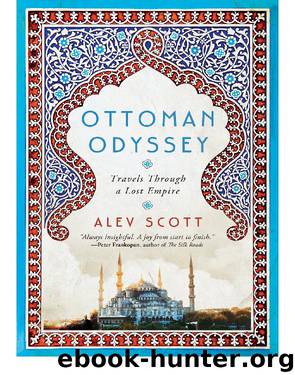Ottoman Odyssey by Alev Scott

Author:Alev Scott
Language: eng
Format: epub
Tags: Epub3
Publisher: Pegasus Books
The Art of War Zones
Andricgrad is a model village built as a film set within the town of Visegrad by Emir Kusturica, the film director as famous for his surreal Palme D’Or-winning art as for his political views. In early 2011, he announced he would be making a film adaptation of Ivo Andric’s book The Bridge on the Drina, and the project is mired in controversy. Sarajevo-born Kusturica is widely despised by his fellow Bosnians for apparently renouncing his heritage and embracing both the Serbian government and its attendant Russian patronage (he converted to the Serbian Orthodox Church on St George’s Day in 2005, and received the Order of Friendship from President Putin in 2016) – a bit like the backlash experienced by French actor Gérard Depardieu, so envied by my friend Ivan in Istanbul.
Andricgrad is as much of a political statement as a cultural project. It is first and foremost an homage to Ivo Andric, although his legacy has been twisted since his death. The Bridge on the Drina, contrary to popular belief, does not paint Muslims as unmitigated villains, but does begin with the building of the bridge in the mid-16th century and the cruelties perpetrated on the Christian locals forced into slave labour by the Ottoman authorities. Today, the bridge serves as a symbol of tension between Muslims and Christians, and this tension is utterly intertwined with nationalist violence. In 1992, Serbian paramilitaries massacred thousands of Bosniak men, women and children in the Visegrad region. Many of them were shot and then thrown from the bridge, and Bosniak women were systematically raped in nearby hotels. The bridge became a perverse symbol of the retribution of Christians against Muslims, supposedly righting the wrongs perpetrated against their Ottoman-subject forefathers hundreds of years ago on the same spot. In a horrible way, Ivo Andric’s book – while not a polemic in itself – can be said to have inspired these reciprocal 20th-century massacres, and Kusturica’s film project is a strange, silent seal of approval.
Battles and massacres can sear the subconscious of a people and shape future political narratives; their details can be augmented and twisted to fit nationalistic agendas centuries after the event. The Bosnian historian Edin Hajdarpasic has written about ‘authentic fantasies’ – grossly exaggerated stories based in historical fact and purporting to carry a central ‘truth’, like a parable or fairy story – used by Balkan nationalists to fuel hatred of historical oppressors and bolster modern political narratives. Historical legend has been warped to portray the Ottoman rule of Balkan Christian subjects as a black-and-white story of ogre-like Turks terrorizing brave, blameless Christians. Hajdarpasic brilliantly compares the ‘authentic fantasies’ of the Balkan nationalists to the Trump administration’s sharing of Islamophobic fake news on social media (with the bogus justification that the message is true even if the story is not), and notes that ‘throughout the 19th century, many Serbian, Croatian, Bulgarian and Greek nationalists developed extensive repertoires – diplomatic memorandums, poems, music, paintings – documenting their struggle for freedom and their suffering at the hands of “the Turks” (a label synonymous with Muslims).
Download
This site does not store any files on its server. We only index and link to content provided by other sites. Please contact the content providers to delete copyright contents if any and email us, we'll remove relevant links or contents immediately.
| Africa | Americas |
| Arctic & Antarctica | Asia |
| Australia & Oceania | Europe |
| Middle East | Russia |
| United States | World |
| Ancient Civilizations | Military |
| Historical Study & Educational Resources |
Byzantium: The Surprising Life of a Medieval Empire by Judith Herrin(620)
Ottoman Odyssey by Alev Scott(614)
Ataturk by unknow(539)
The Sultan's Admiral by Ernle Bradford(525)
For God or Empire by Jacob Wilson Chacko;(482)
They Can Live in the Desert but Nowhere Else" (Human Rights and Crimes against Humanity) by Ronald Grigor Suny(431)
Sacred Swords: Jihad in the Holy Land, 1097–1291 by Waterson James(428)
Against Massacre by Rodogno Davide(416)
Arab Patriotism: The Ideology and Culture of Power in Late Ottoman Egypt by Adam Mestyan(410)
Rebel Land by Christopher de Bellaigue(409)
The Empress Nurbanu and Ottoman Politics in the Sixteenth Century by Pinar Kayaalp(382)
The Siege of Kut-al-Amara: At War in Mesopotamia, 1915-1916 (Twentieth-Century Battles) by Gardner Nikolas(369)
The Turks in World History by Carter Vaughn Findley(368)
Arabs and Jews in Ottoman Palestine by Alan Dowty(363)
The Ottoman Road to War in 1914 by Mustafa Aksakal(350)
The New Turkey and Its Discontents by Waldman Simon; Caliskan Emre;(341)
Khashoggi and the Crown Prince by Owen Wilson(340)
Ali Pasha, Lion of Ioannina by Eugenia Russell & Eugenia Russell & Eugenia Russell(332)
To Save an Empire by Allan R. Gall(326)
